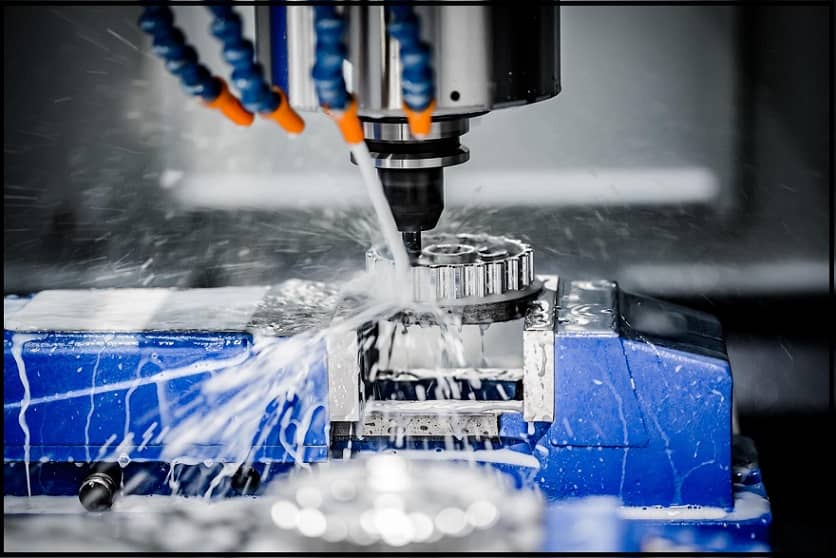When manufacturing parts, products, and prototypes, many manufacturers utilize a subtractive process known as CNC machining. This streamlined technology reduces production time and costs while providing consistent product quality. A CNC machine cuts raw material based on instructions provided by an operator. These instructions, called G-code, are interpreted by the machine control unit (MCU). The MCU then interfaces with the servo motors and spindle motors.
Cutter Design
What are the basics of live tooling? When a machinist inserts a live tool into a lathe, a turret or sub-spindle holds it within the workpiece. Various turret designs exist, from disc and face-mount versions to radial and star. Regardless of the invention, each holds a set of specialized tools and clamps them in a way that allows them to perform off-center cutting operations while the workpiece remains oriented toward the main spindle. The design of these special tools is an important consideration when evaluating live tooling for CNC machines. They must withstand the forces exerted on them by the machining process, including radial and axial cutting and feed forces.
In many cases, these forces may not be equal and must be balanced. A tangential cut, for example, may place more emphasis on the axial direction than a radial cut, but it also tends to require more rapid feeds and higher speeds. In addition to drilling and tapping, live tools can also be equipped with milling units, enabling the machine to perform milling operations on the part in the process. This can be much faster than removing the product from the lathe and loading it into a mill for a separate, secondary milling operation. It can also be more cost-effective when producing large families of parts, as a dedicated set of tools for each detail might otherwise need to be purchased.
Cutter Geometry
The geometry of the cutting edge has a significant impact on machining forces. Cutter geometries are divided into macro geometry (rake, clearance, and wedge angle) and micro geometry (cutting edge rounding, chamfer geometry, and cutting edge radius). The latter has a significant effect on the amount of chipping generated, as well as on the forces exerted on the workpiece and tool. A key to effective live tooling is a good match between the tool shank design and the clamping system. Various turrets, sub-spindles, and milling spindles used in multitasking machines and live-tool lathes require clamping systems that accommodate a wide range of standard round tools of different sizes. These include collet chucks, arbors, Weldon, caps, whistle notch, and hydraulic clamping systems. In addition, the axial and radial cutting forces exerted on the cutter must be balanced to ensure part feature location tolerances are met. This requires matching the cutter diameter to the machine’s spindle capacity and adequately mounting the tool in the turret station. In addition to balancing these factors, shops should consider using a high-speed live-tool turret and a direct-drive motor for powering the live tool. This enables machinists to increase speeds beyond what conventional turrets can achieve, and this capability has driven the evolution of live tooling technology in recent years.
Cutter Material
Cutter materials used in live tooling are grouped into two categories. Durable materials remain stable under the heat generated during machining and do not lose their hardness. In contrast, hazardous materials tend to melt or soften due to the high temperatures involved in machining. Straight tungsten carbide, for example, can be used to machine gray cast iron and most nonferrous metals, but it can quickly form a crater on the cutting edge when cut against steel. To combat this, titanium and tantalum are added to create a tungsten carbide-titanium alloy with better abrasion resistance. To improve the cutting capability of a lathe with live tooling, a rotary C-axis is attached to the turret, transforming it into a 4-axis machine. Tiny motors mounted in the turret provide a controlled rotary motion to the tools, allowing the lathe to make contouring cuts that are impossible with standard turning operations alone. In addition to enabling complex turning operations, live tooling can perform milling processes, such as edge rounding/squaring and adding axial/radial features to a component. This is a significant time-saver compared to stopping the turning process, removing the product from the lathe, and loading it into a CNC mill. It also prevents rework and inspection delays. The newest live tools are much more substantial and faster, making them even more appealing for manufacturers wanting to increase their versatility in a single machine.
Cutter Life
A live tooling system in a CNC lathe brings a mill into the machine, moving across the workpiece to create a flat surface. This subtractive machining method speeds up production and reduces costs. The addition of a live tooling system enables a CNC lathe to perform more complex metal-cutting operations, like drilling and tapping. It also allows the turret to index and perform contouring milling motions in 4-axis machines. Many lathe manufacturers offer a variety of work holders to fit a wide range of live tooling applications. However, shops must carefully evaluate these holders to ensure they match the application and are compatible with the tool shank design. A work holder that extends three to four times its diameter could overburden the relatively small spindle bearings within the turret. Or, if the stick-out is too great in the radial direction, it may hit the part during indexing and cause damage to the turret and the tool.

